Thin-Film PVD Coating Metamaterials Exhibiting Similarities to Natural Processes under Extreme Tribological Conditions
Abstract
1. Introduction
2. Adaptive Surface-Engineered Systems
2.1. Tribofilms Characteristics: Composition, Structural Characteristics, and Temporal Behavior of Tribo-Films
2.1.1. Composition of the Tribo-Films
2.1.2. Structural Characteristics of Tribo-Films in Relation to Their Spatial/Temporal Behavior
2.2. Coating Layer
3. Conclusions
- openness by means of adaptive interaction with a non-equilibrium severe environment,
- formation of the compounds such as sapphire, mullite, garnet, and others, similar to those that develop as a result of metamorphism,
- temporal behavior and ability to evolve with time,
- complexity and multifunctionality,
- emergent (synergetic) performance.
Author Contributions
Funding
Acknowledgments
Conflicts of Interest
References
- Beckerman, L.P. Application of complex systems science to systems engineering. Syst. Eng. 2000, 3, 96–102. [Google Scholar] [CrossRef]
- Feynman, R.P.; Brown, L.M. (Eds.) Selected Papers of Richard Feynman: With Commentary. In 20th Century Physics; World Scientific: Singapore, 2000; ISBN 978-981-02-4131-5. [Google Scholar]
- Goldsmith, E. Evolution, neo-Darwinism and the paradigm of science. Ecologist 1990, 20, 67. [Google Scholar]
- Trogadas, P.; Coppens, M.-O. Nature-Inspired Chemical Engineering: A New Design Methodology for Sustainability. In Sustainable Nanoscale Engineering; Szekely, G., Ed.; Elsevier: Amsterdam, The Netherlands, 2019; Chapter 2. [Google Scholar]
- Lehn, J.-M. Toward Self-Organization and Complex Matter. Science 2002, 29, 2400–2403. [Google Scholar] [CrossRef] [PubMed]
- Goldenfeld, N. Simple Lessons from Complexity. Science 1999, 284, 87–89. [Google Scholar] [CrossRef] [PubMed]
- Eigen, M. Self-organization of matter and the evolution of biological macromolecules. Naturwissenschaften 1971, 58, 465–523. [Google Scholar] [CrossRef]
- Yates, F.E. (Ed.) Self-Organizing Systems; Plenum: New York, NY, USA, 1987. [Google Scholar]
- Brackmann, S. On the generation of information as motive power for molecular evolution. Biophys. Chem. 1997, 66, 133–143. [Google Scholar] [CrossRef]
- Feistel, R.; Ebeling, W. Introduction to the Field of Self-Organization, in Physics of Self-Organization and Evolution; Wiley-VCH Verlag GmbH & Co. KGaA: Weinheim, Germany, 2011; pp. 1–33. [Google Scholar]
- Fox-Rabinovich, G.; Kovalev, A.; Veldhuis, S.; Yamamoto, K.; Endrino, J.L.; Gershman, I.S.; Rashkovskiy, A.; Aguirre, M.H.; Wainstein, D.L. Spatio-temporal behaviour of atomic-scale tribo-ceramic films in adaptive surface engineered nano-materials. Sci. Rep. 2015, 5, 8780. [Google Scholar] [CrossRef] [PubMed]
- Fox-Rabinovich, G.; Kovalev, A.; Aguirre, M.H.; Yamamoto, K.; Veldhuis, S.; Gershman, I.; Rashkovskiy, A.; Endrino, J.L.; Beake, B.; Dosbaeva, G.; et al. Evolution of self-organization in nano-structured PVD coatings under extreme tribological conditions. Appl. Surf. Sci. 2014, 297, 22–32. [Google Scholar] [CrossRef]
- Fox-Rabinovich, G.; Yamamoto, K.; Beake, B.; Gershman, I.; Kovalev, A.; Aguirre, M.; Veldhuis, S.; Dosbaeva, G.; Endrino, J. Hierarchical adaptive nano-structured PVD coatings for extreme tribological applications: The quest for non-equilibrium states and emergent behavior. Sci. Technol. Adv. Mater. 2012, 13, 043001. [Google Scholar] [CrossRef] [PubMed]
- Jones, R.L. Soft Machines; Oxford University Press: Oxford, UK, 2004. [Google Scholar]
- Bhushan, B. Biomimetics: Lessons from nature—An overview. Philos. Trans. R. Soc. A 2009, 367, 1445–1486. [Google Scholar] [CrossRef]
- Zimmerman, B.; Lindberg, C.; Plsek, P. A Complexity Science Primer. In Edgeware: Insights from Complexity Science for Health Care Leaders; VHA Inc.: Irving, TX, USA, 2001; pp. 3–20. [Google Scholar]
- Schneider, M.; Somers, M. Organizations as complex adaptive systems: Implications of Complexity Theory for leadership research. Leadersh. Q. 2006, 17, 351–365. [Google Scholar] [CrossRef]
- Prigogine, I. Time, Structure, and Fluctuations. Science 1978, 201, 777–785. [Google Scholar] [CrossRef] [PubMed]
- Prigogine, I. The philosophy of instability. Futures 1989, 21, 396–400. [Google Scholar] [CrossRef]
- Prigogine, I. Science, civilization and democracy: Values, systems, structures and affinities. Futures 1986, 18, 493–507. [Google Scholar] [CrossRef]
- Prigogine, I. Introduction to Thermodynamics of Irreversible Processes, 2nd ed.; Wiley-Interscience: New York, NY, USA, 1961. [Google Scholar]
- Amiri, M.; Khonsari, M. On the Thermodynamics of Friction and Wear―A Review. Entropy 2010, 12, 1021–1049. [Google Scholar] [CrossRef]
- Yuan, J.; Fox-Rabinovich, G.S.; Veldhuis, S.C. Control of tribofilm formation in dry machining of hardened AISI D2 steel by tuning the cutting speed. Wear 2018, 402–403, 30–37. [Google Scholar] [CrossRef]
- Karma, A. Spiralling to destruction at the edge of chaos. Nature 1996, 379, 118–119. [Google Scholar] [CrossRef]
- Bouzakis, K.-D.; Michailidis, N.; Skordaris, G.; Bouzakis, E.; Biermann, D.; M’Saoubi, R. Cutting with coated tools: Coating technologies, characterization methods and performance optimization. CIRP Ann. 2012, 61, 703–723. [Google Scholar] [CrossRef]
- Ning, L.; Veldhuis, S.; Yamamoto, K. Investigation of wear behavior and chip formation for cutting tools with nano-multilayered TiAlCrN/NbN PVD coating. Int. J. Mach. Tools Manuf. 2008, 48, 656–665. [Google Scholar] [CrossRef]
- Fox-Rabinovich, G. Emergent behavior of nano-multilayered coatings during dry high-speed machining of hardened tool steels. Surf. Coat. Technol. 2010, 204, 3425–3435. [Google Scholar] [CrossRef]
- Chowdhury, S.; Beake, B.; Yamamoto, K.; Bose, B.; Aguirre, M.; Fox-Rabinovich, G.; Veldhuis, S. Improvement of Wear Performance of Nano-Multilayer PVD Coatings under Dry Hard End Milling Conditions Based on Their Architectural Development. Coatings 2018, 8, 59. [Google Scholar] [CrossRef]
- Hobbs, G.; Scheepers, R. Agility in Information Systems: Enabling Capabilities for the IT Function. Pac. Asia J. Assoc. Inf. Syst. 2010, 2, 1–27. [Google Scholar]
- Buehler, M.J.; Keten, S.; Ackbarow, T. Theoretical and computational hierarchical nanomechanics of protein materials: Deformation and fracture. Prog. Mater. Sci. 2008, 53, 1101–1241. [Google Scholar] [CrossRef]
- Anderson, P. More Is Different. Broken symmetry and the nature of the hierarchical structure of science. Science 1972, 177, 393–396. [Google Scholar] [CrossRef] [PubMed]
- Testa, B.; Kier, L.B. Emergence and Dissolvence in the Self-organisation of Complex Systems. Entropy 2000, 2, 1–25. [Google Scholar] [CrossRef]
- Newell, B.; Crumley, C.L.; Hassan, N.; Lambin, E.F.; Pahl-Wostl, C.; Underdal, A.; Wasson, R. A conceptual template for integrative human–environment research. Glob. Environ. Chang. 2005, 15, 299–307. [Google Scholar] [CrossRef]
- Dyball, R.S.; Beavis, S.; Kaufman, S. Complex adaptive systems: Constructing mental models. In Social Learning in Environmental Management: Towards a Sustainable Future; Meg Keen, M., Valerie, A., Brown, V., Dyball, R., Eds.; Earthscan: New York, NY, USA, 2012; pp. 41–58. [Google Scholar]
- Fox-Rabinovich, G.; Gershman, I.; Yamamoto, K.; Biksa, A.; Veldhuis, S.; Beake, B.; Kovalev, A. Self-Organization during Friction in Complex Surface Engineered Tribosystems. Entropy 2010, 12, 275–288. [Google Scholar] [CrossRef]
- Gell-Mann, M. What is complexity? Remarks on simplicity and complexity by the Nobel Prize-winning author of The Quark and the Jaguar. Complexity 1995, 1, 16–19. [Google Scholar] [CrossRef]
- Gershenson, C. Guiding the self-organization of random Boolean networks. Theory Biosci. 2012, 131, 181–191. [Google Scholar] [CrossRef]
- Gershenson, C.; Fernández, N. Complexity and information: Measuring emergence, self-organization, and homeostasis at multiple scales. Complexity 2012, 18, 29–44. [Google Scholar] [CrossRef]
- Yeh, J.-W.; Lin, S.-J.; Tsai, M.-H.; Chang, S.-Y. High-Entropy Coatings. In High-Entropy Alloys; Springer International Publishing: Cham, Switzerland, 2016; pp. 469–491. [Google Scholar] [CrossRef]
- Hsieh, M.; Tsai, M.; Wan-Jui Shen, W.; Yeh, J. Structure and properties of two Al–Cr–Nb–Si–Ti high-entropy nitride coatings. Surf. Coat. Technol. 2013, 221, 118–123. [Google Scholar] [CrossRef]
- Yeh, J.; Lin, S. Breakthrough applications of high-entropy materials. J. Mater. Res. 2018, 33, 3129–3137. [Google Scholar] [CrossRef]
- Shen, W.-J.; Tsai, M.-H.; Yeh, J.-W. Machining Performance of Sputter-Deposited (Al0.34Cr0.22Nb0.11Si0.11Ti0.22)50N50 High-Entropy Nitride Coatings. Coatings 2015, 5, 312–325. [Google Scholar] [CrossRef]
- Wu, W.-H.; Yang, C.-C.; Yeh, J.-W. Industrial development of high-entropy alloys. Ann. Chim. Sci. des Matériaux 2006, 31, 737–747. [Google Scholar] [CrossRef]
- Cheng, K.-H.; Lai, C.-H.; Lin, S.-J.; Yeh, J.-W. Structural and mechanical properties of multi-element (AlCrMoTaTiZr)Nx coatings by reactive magnetron sputtering. Thin Solid Films 2011, 519, 3185–3190. [Google Scholar] [CrossRef]
- Pogrebnjak, A.D.; Bagdasaryan, A.A.; Yakushchenko, I.V.; Beresnev, V.M. The structure and properties of high-entropy alloys and nitride coatings based on them. Russ. Chem. Rev. 2014, 83, 1027–1061. [Google Scholar] [CrossRef]
- Voevodin, A.; Zabinski, J. Load-adaptive crystalline amorphous nanocomposites. J. Mater. Sci. 1998, 33, 319–327. [Google Scholar] [CrossRef]
- Kutschej, K.; Mayrhofer, P.; Kathrein, M.; Polcik, P.; Mitterer, C. Influence of oxide phase formation on the tribological behaviour of Ti–Al–V–N coatings. Surf. Coat. Technol. 2005, 200, 1731–1737. [Google Scholar] [CrossRef]
- Fox-Rabinovich, G.; Totten, G. Self-Organization during Friction; CRC Press Tailor and Francis: Boca Raton, FL, USA, 2006. [Google Scholar]
- Fox-Rabinovich, G.; Kovalev, A.; Gershman, I.; Wainstein, D.; Aguirre, M.; Covelli, D.; Paiva, J.; Yamamoto, K.; Veldhuis, S. Complex Behavior of Nano-Scale Tribo-Ceramic Films in Adaptive PVD Coatings under Extreme Tribological Conditions. Entropy 2018, 20, 989. [Google Scholar] [CrossRef]
- Kostetsky, B. Friction, Lubrication and Wear in Machines; Technika: Kiev, Ukraine, 1970. [Google Scholar]
- Jacobson, S.; Hogmark, S. Tribofilms—On the crucial importance of tribologically induced surface modifications. In Recent Developments in Wear Prevention, Friction and Lubrication; Nikas, G., Ed.; Research Signpost: Kerala, India, 2010; p. 197. [Google Scholar]
- Mansson, B.; Lindgren, K. Thermodynamics, information and structure. In Nonequilibrium Theory and Extremum Principles; Sieniutycz, S., Salamon, P., Eds.; Taylor and Francis: New York, NY, USA, 1990; p. 95. [Google Scholar]
- Kostetskaya, N. Mechanisms of deformation, fracture and wear particles forming during the mechanical-chemical friction. J. Frict. Wear 1990, 16, 108–115. [Google Scholar]
- Bershadskiy, L. On self-organizing and concept of tribosystem self-organizing. J. Frict. Wear 1992, 8, 1077–1094. [Google Scholar]
- Kostetsky, B. An evolution of the materials’ structure and phase composition and the mechanisms of the self-organizing phenomenon at external friction. J. Frict. Wear 1993, 14, 773–783. [Google Scholar]
- Fox-Rabinovich, G.S.; Endrino, J.L.; Aguirre, M.H.; Beake, B.D.; Veldhuis, S.C.; Kovalev, A.I.; Gershman, I.S.; Yamamoto, K.; Losset, Y.; Wainstein, D.L.; et al. Mechanism of adaptability for the nano-structured TiAlCrSiYN-based hard physical vapor deposition coatings under extreme frictional conditions. J. Appl. Phys. 2012, 111, 064306. [Google Scholar] [CrossRef]
- Kovalev, A.; Wainstein, D.; Rashkovskiy, A. Investigation of anomalous physical properties of multilayer nanolaminate (TiAl)N/Cu coatings by electron spectroscopy techniques. Surf. Interface Anal. 2010, 42, 1361–1363. [Google Scholar] [CrossRef]
- Lee, D.W.; Kingery, W.D. Radiation Energy Transfer and Thermal Conductivity of Ceramic Oxides. Am. Cer. Soc. 1960, 43, 594–607. [Google Scholar] [CrossRef]
- Padture, N.P.; Klemens, P.G. Low Thermal Conductivity in Garnets. J. Am. Ceram. Soc. 2005, 80, 1018–1020. [Google Scholar] [CrossRef]
- Khatibi, A. Growth and Heat Treatment Studies of Al-Cr-O and Al-Cr-N Films. Ph.D. Thesis, Linkoping Univesity, Linkoping, Sweeden, 2013. [Google Scholar]
- Maiman, T. Stimulated Optical Radiation in Ruby. Nature 1960, 187, 493–494. [Google Scholar] [CrossRef]
- Prigogine, I. From Being to Becoming: Time and Complexity in the Physical Sciences; W. H. Freeman: San Francisco, CA, USA, 1980. [Google Scholar]
- Steinfeld, J.I.; Francisco, J.S.; Hase, W.L. Chemical Kinetics and Dynamics, 2nd ed.; Prentice-Hall: Upper Saddle River, NJ, USA, 1999. [Google Scholar]
- Kruhl, J. Fractals and Dynamic Systems in Geoscience; Springer: Berlin/Heidelberg, Germany, 2013. [Google Scholar]
- Dobrzhinetskaya, L.; Green, H.; Weschler, M.; Darus, M.; Wang, Y.-C.; Massonne, H.-J.; Stöckhert, B. Focused ion beam technique and transmission electron microscope studies of microdiamonds from the Saxonian Erzgebirge, Germany. Earth Planet Sci. Lett. 2003, 210, 399–410. [Google Scholar] [CrossRef]
- Dobrzhinetskaya, L.; Wali Faryad, S.; Wallis, S.; Cuthbert, S. Ultra-High Pressure Metamorphism: 25 Years after The Discovery of Coesite and Diamond; Elsevier: London, UK, 2011. [Google Scholar]
- Krebs, R. The Basics of Earth Science; Library of Congress: Washington, DC, USA, 1922. [Google Scholar]
- Bak, P.; Tang, C.; Wiesenfeld, K. Self-organized criticality. Phys. Rev. A 1988, 38, 364–374. [Google Scholar] [CrossRef]
- Bak, P. How Nature Works: The Science of Self-Organized Criticality; Springer: Berlin/Heidelberg, Germany, 1999; p. 155. [Google Scholar]
- AlAnazi, F.; Ghosh, S.; Dunnigan, R.; Gupta, S. Synthesis and tribological behavior of novel Ag- and Bi-based composites reinforced with Ti3SiC2. Wear 2017, 376–377, 1074–1083. [Google Scholar] [CrossRef]
- Yuan, J.; Yamamoto, K.; Covelli, D.; Tauhiduzzaman, M.; Arif, T.; Gershman, I.S.; Veldhuis, S.C.; Fox-Rabinovich, G.S. Tribo-films control in adaptive TiAlCrSiYN/TiAlCrN multilayer PVD coating by accelerating the initial machining conditions. Surf. Coat. Technol. 2016, 294, 54–61. [Google Scholar] [CrossRef]
- Watari, K.; Ishizaki, K.; Tsuchiya, F. Phonon scattering and thermal conduction mechanisms of sintered aluminium nitride ceramics. J. Mater. Sci. 1993, 28, 3709–3714. [Google Scholar] [CrossRef]
- Barsoum, M.W. Fundamentals of Ceramics; CRC Press: Boca Raton, FL, USA, 2002; ISBN 9780750309028. [Google Scholar]
- Grasso, S.; Tsujii, N.; Jiang, Q.; Khaliq, J.; Maruyama, S.; Miranda, M.; Simpson, K.; Mori, T.; Reece, M.J. Ultra low thermal conductivity of disordered layered p-type bismuth telluride. J. Mater. Chem. C 2013, 1, 2362. [Google Scholar] [CrossRef]
- Fox-Rabinovich, G.; Gershman, I.; Yamamoto, K.; Aguirre, M.; Covelli, D.; Arif, T.; Aramesh, M.; Shalaby, M.; Veldhuis, S. Surface/interface phenomena in nano-multilayer coating under severing tribological conditions. Surf. Interface Anal. 2017, 49, 584–593. [Google Scholar] [CrossRef]
- Shanmugavel, P.; Bhaskar, G.B.; Chandrasekaran, M.; Mani, P.S.; Srinivasan, S.P. An overview of fracture analysis in functionally graded materials. Eur. J. Sci. Res. 2012, 68, 412–439. [Google Scholar]
- Atai, A.A.; Nikranjbar, A.; Kasiri, R. Buckling and post-buckling behaviour of semicircular functionally graded material arches: A theoretical study. Proc. Inst. Mech. Eng. Part C J. Mech. Eng. Sci. 2012, 226, 607–614. [Google Scholar] [CrossRef]
- Mahamood, R.M.; Akinlabi, E.T. Processing Methods of Functionally Graded Materials. In Functionally Graded Materials. Topics in Mining, Metallurgy and Materials Engineering; Springer: Cham, Switzerland, 2017. [Google Scholar] [CrossRef]
- Knoppers, R.; Gunnink, J.W.; Van den Hout, J.; Van Vliet, W. The Reality of Functionally Graded Material Products; TNO Science and Industry: Delft, The Netherlands, 2010; pp. 38–43. [Google Scholar]
- Kshetrimayum, R.S. A brief intro to metamaterials. IEEE Potentials 2005, 23, 44–46. [Google Scholar] [CrossRef]
- Lee, J.-H.; Singer, J.P.; Thomas, E.L. Micro-/Nanostructured Mechanical Metamaterials. Adv. Mater. 2012, 24, 4782–4810. [Google Scholar] [CrossRef]
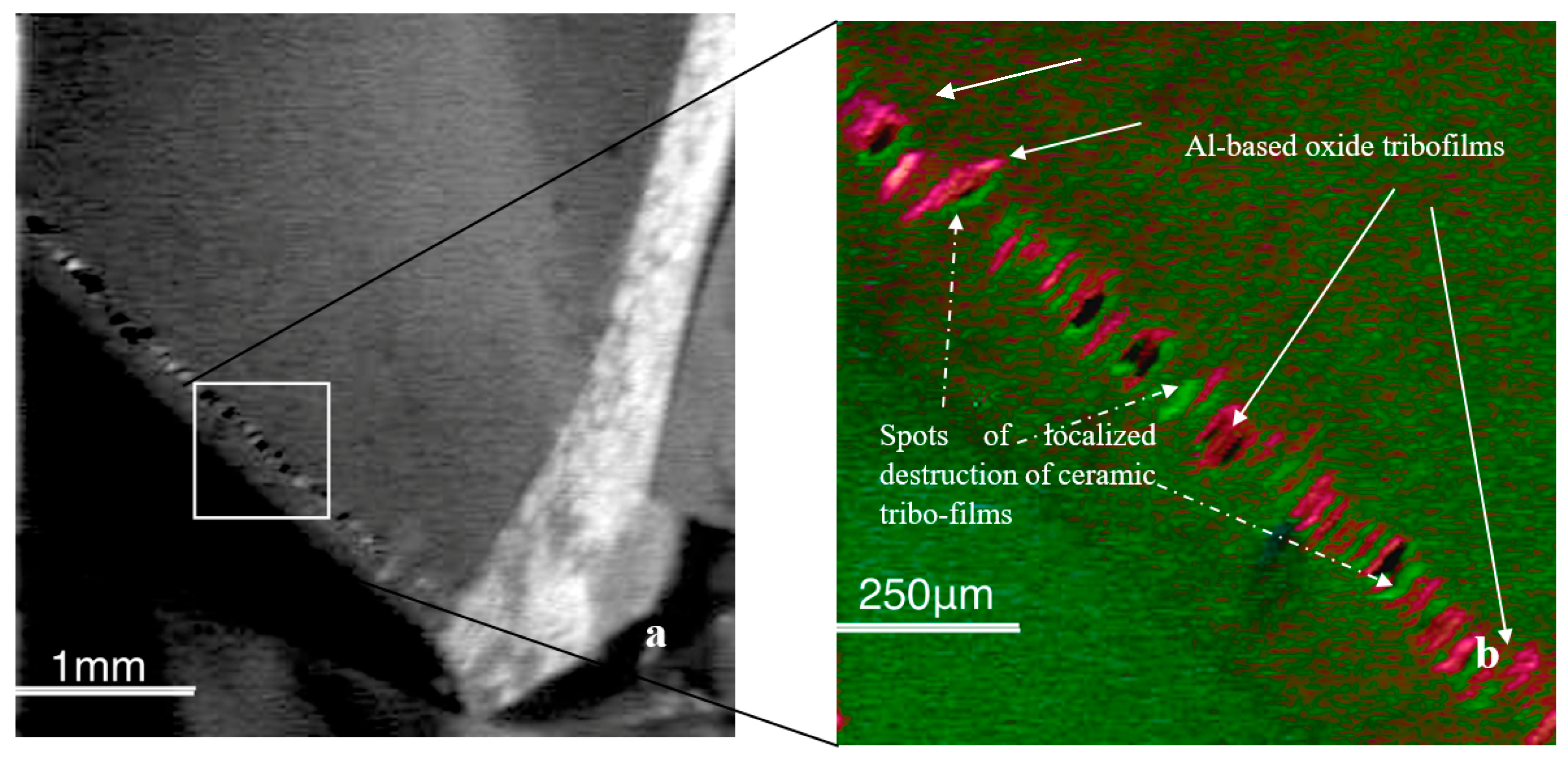

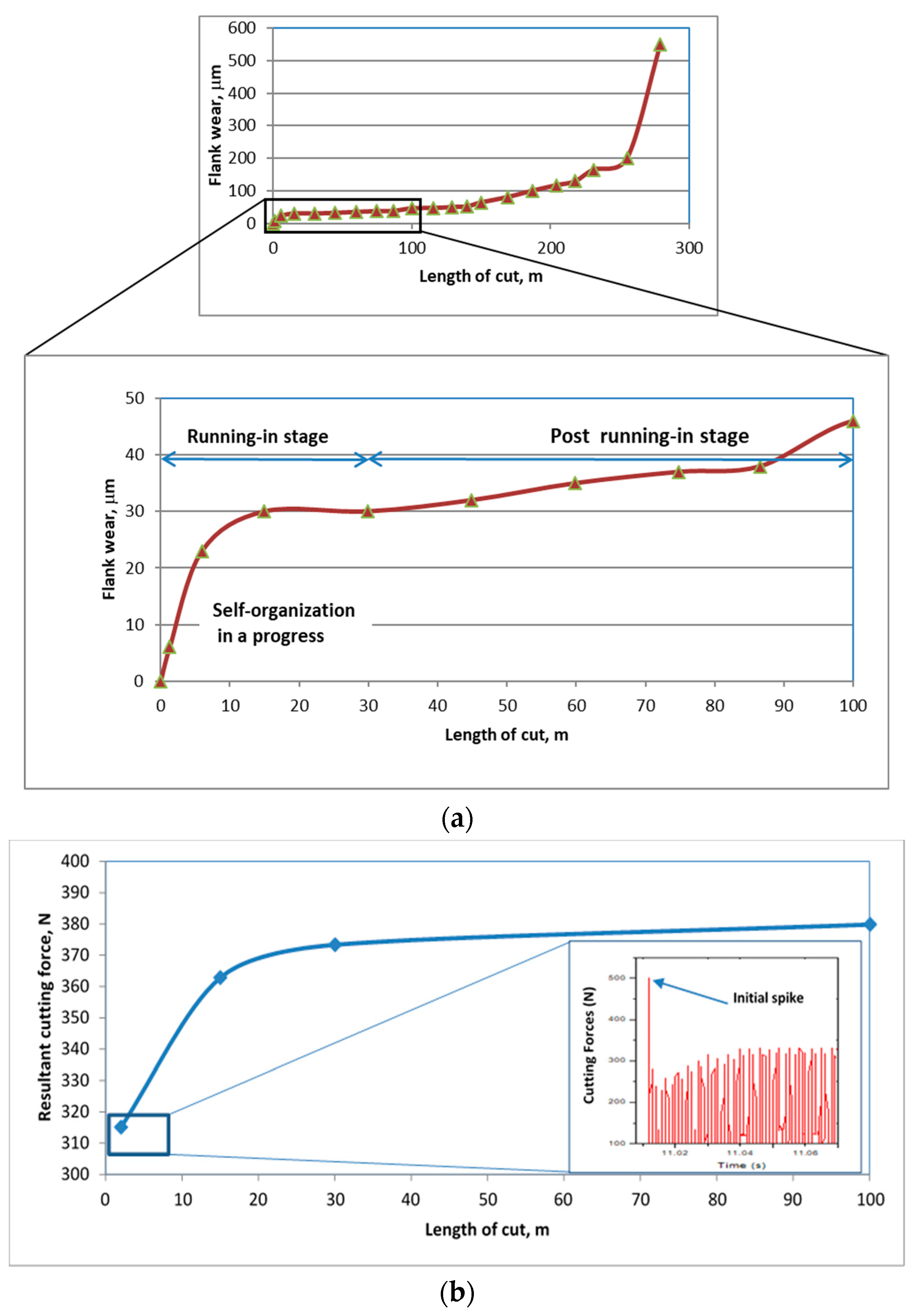
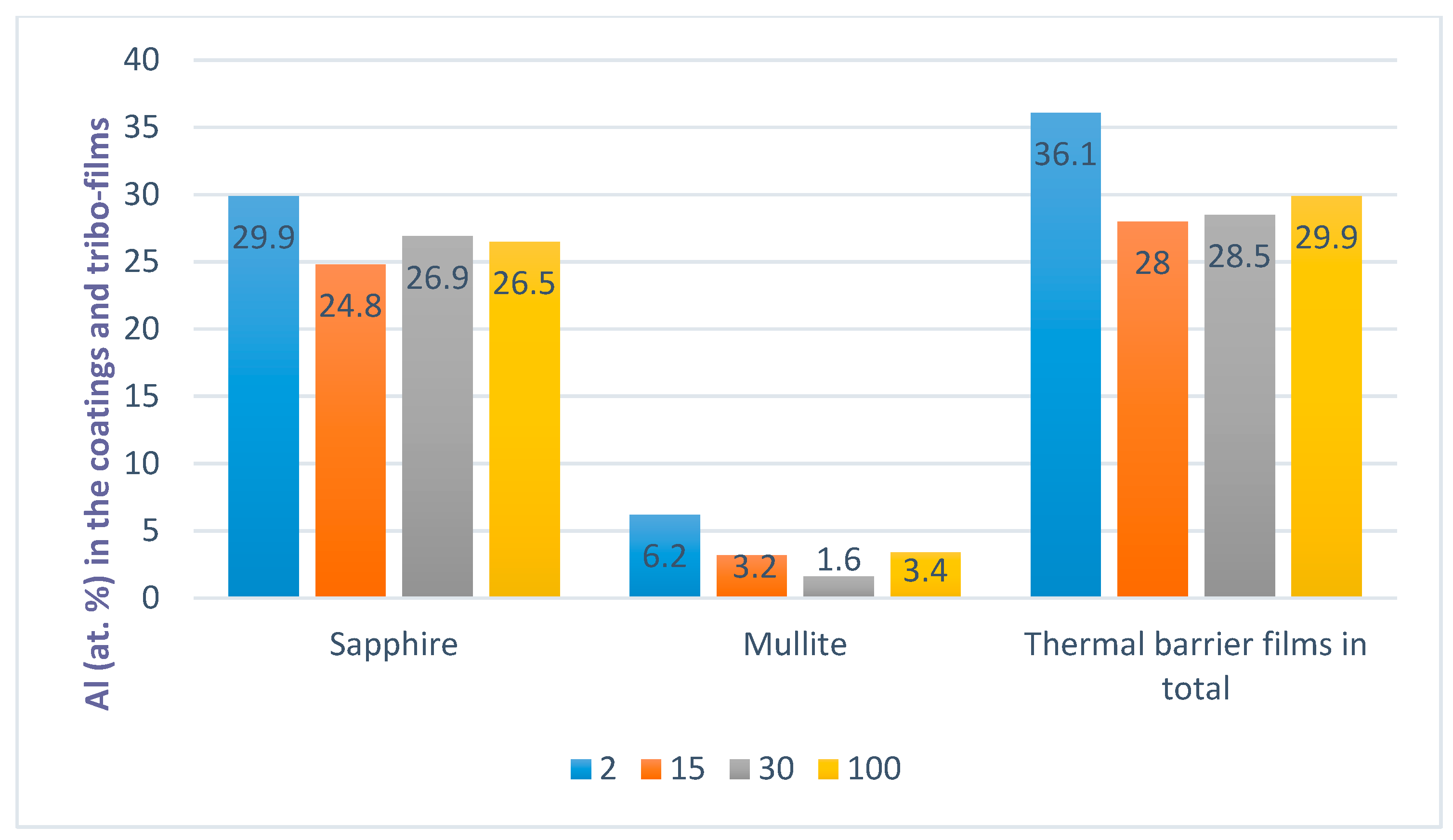
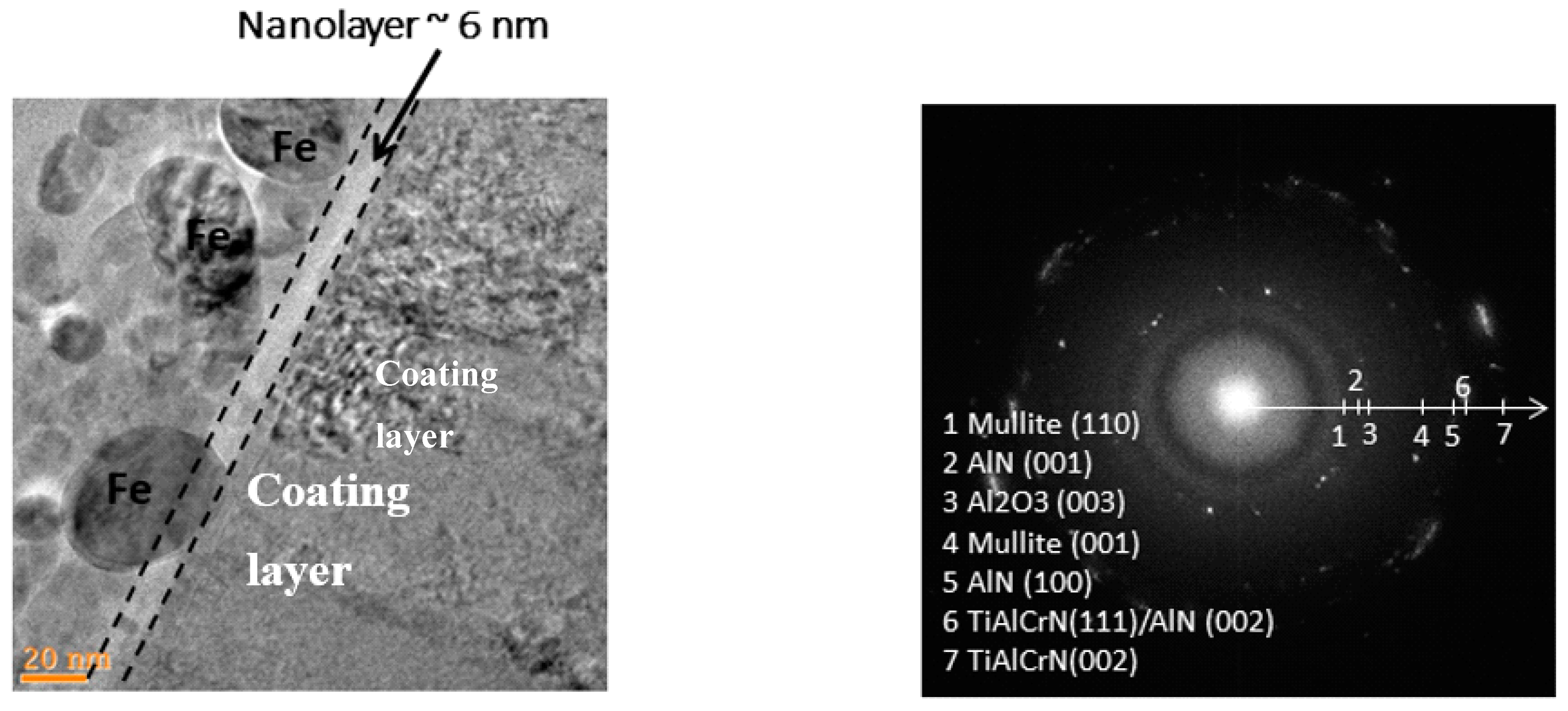

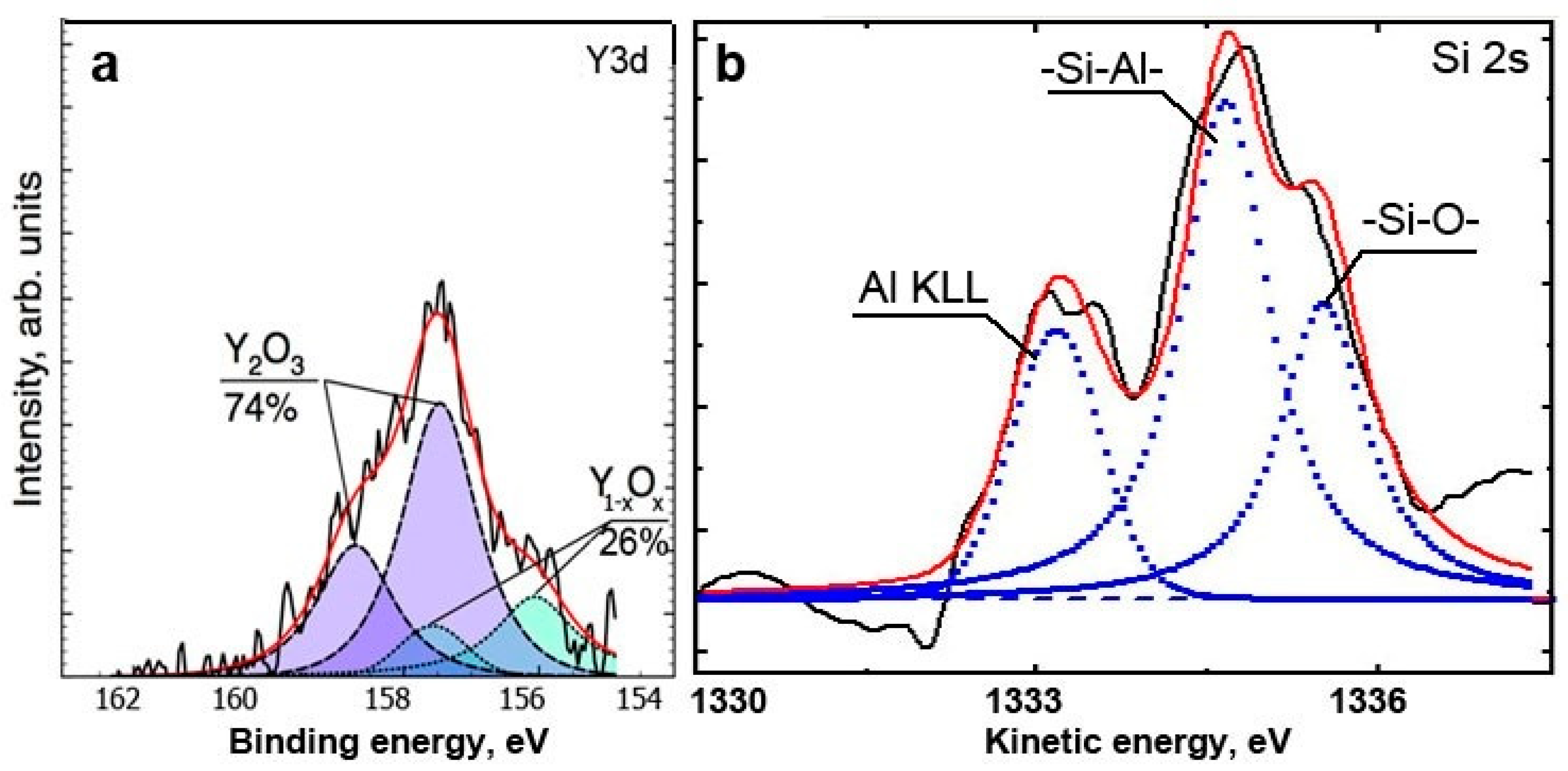
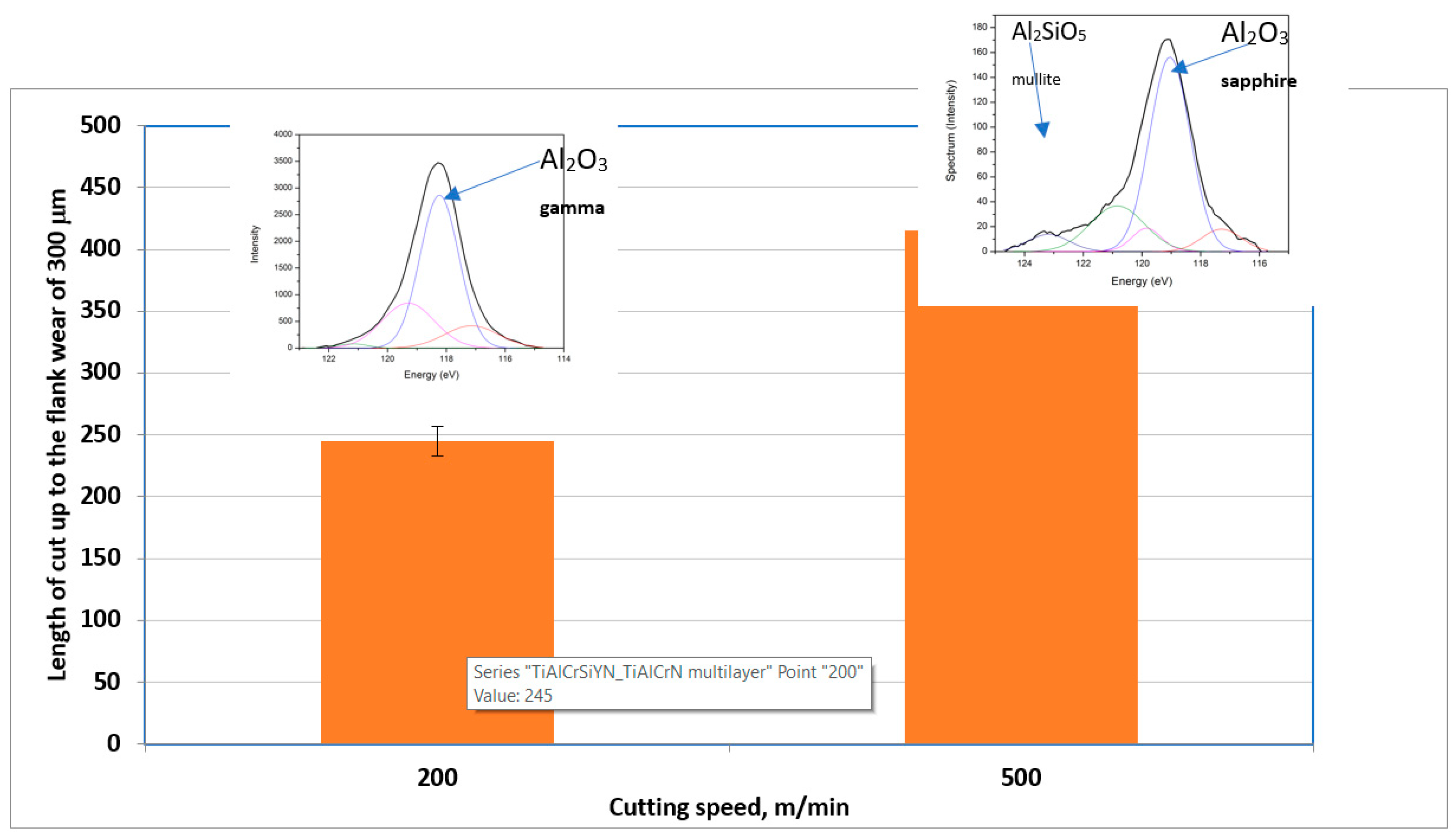
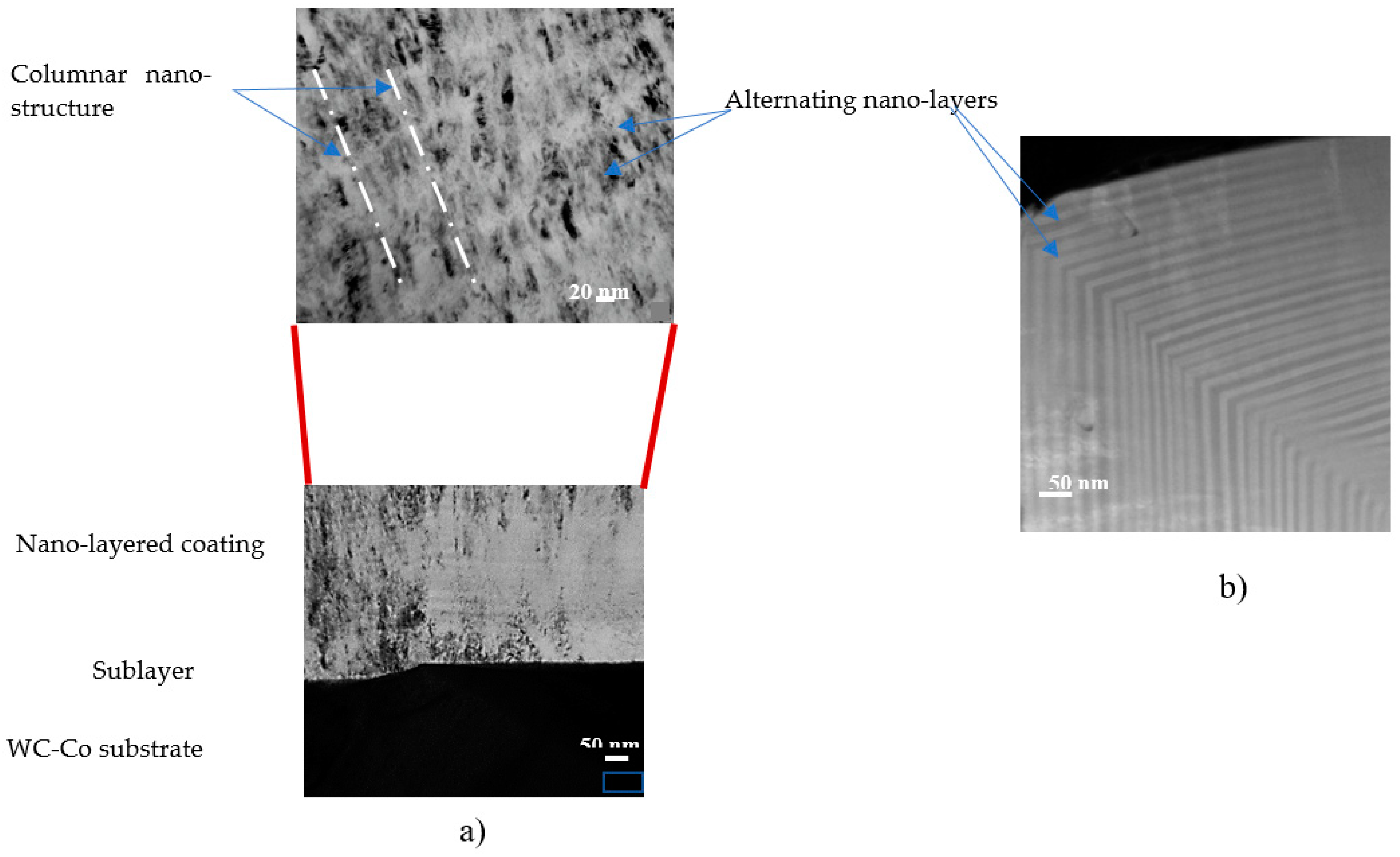
| Coating | Thickness, Microns | Hardness, GPa | Reduced Elastic Modulus, GPa | H/Er Ratio | H3/Er2 Ratio | CPRs Parameter Lc1(Lc2−Lc1) ‘Scratch Crack Propagation Resistance’ | Residual Stresses, GPa |
|---|---|---|---|---|---|---|---|
| Ti0.2Al0.55Cr0.2Si0.03Y0.02N/Ti0.25Al0.65Cr0.1N Multilayer | 2 | 28.4 ± 4.5 | 327.1 | 0.087 | 0.212 | 1.9 | −7.09 ± 0.6 |
| Ti0.2Al0.55Cr0.2Si0.03Y0.02N/Ti0.25Al0.65Cr0.1N Bi-Multilayer | 2 | 31.59 ± 2.5 | 329.07 | 0.095 | 0.291 | 5.8 | −6.99 ± 0.5 |
© 2020 by the authors. Licensee MDPI, Basel, Switzerland. This article is an open access article distributed under the terms and conditions of the Creative Commons Attribution (CC BY) license (http://creativecommons.org/licenses/by/4.0/).
Share and Cite
Fox-Rabinovich, G.S.; Gershman, I.S.; Veldhuis, S. Thin-Film PVD Coating Metamaterials Exhibiting Similarities to Natural Processes under Extreme Tribological Conditions. Nanomaterials 2020, 10, 1720. https://doi.org/10.3390/nano10091720
Fox-Rabinovich GS, Gershman IS, Veldhuis S. Thin-Film PVD Coating Metamaterials Exhibiting Similarities to Natural Processes under Extreme Tribological Conditions. Nanomaterials. 2020; 10(9):1720. https://doi.org/10.3390/nano10091720
Chicago/Turabian StyleFox-Rabinovich, G. S., I. S. Gershman, and S. Veldhuis. 2020. "Thin-Film PVD Coating Metamaterials Exhibiting Similarities to Natural Processes under Extreme Tribological Conditions" Nanomaterials 10, no. 9: 1720. https://doi.org/10.3390/nano10091720
APA StyleFox-Rabinovich, G. S., Gershman, I. S., & Veldhuis, S. (2020). Thin-Film PVD Coating Metamaterials Exhibiting Similarities to Natural Processes under Extreme Tribological Conditions. Nanomaterials, 10(9), 1720. https://doi.org/10.3390/nano10091720







